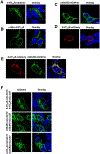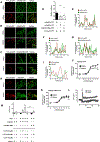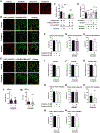Interclass GPCR heteromerization affects localization and trafficking
- PMID: 33082287
- PMCID: PMC7717648
- DOI: 10.1126/scisignal.aaw3122
Interclass GPCR heteromerization affects localization and trafficking
Abstract
Membrane trafficking processes regulate G protein-coupled receptor (GPCR) activity. Although class A GPCRs are capable of activating G proteins in a monomeric form, they can also potentially assemble into functional GPCR heteromers. Here, we showed that the class A serotonin 5-HT2A receptors (5-HT2ARs) affected the localization and trafficking of class C metabotropic glutamate receptor 2 (mGluR2) through a mechanism that required their assembly as heteromers in mammalian cells. In the absence of agonists, 5-HT2AR was primarily localized within intracellular compartments, and coexpression of 5-HT2AR with mGluR2 increased the intracellular distribution of the otherwise plasma membrane-localized mGluR2. Agonists for either 5-HT2AR or mGluR2 differentially affected trafficking through Rab5-positive endosomes in cells expressing each component of the 5-HT2AR-mGluR2 heterocomplex alone, or together. In addition, overnight pharmacological 5-HT2AR blockade with clozapine, but not with M100907, decreased mGluR2 density through a mechanism that involved heteromerization between 5-HT2AR and mGluR2. Using TAT-tagged peptides and chimeric constructs that are unable to form the interclass 5-HT2AR-mGluR2 complex, we demonstrated that heteromerization was necessary for the 5-HT2AR-dependent effects on mGluR2 subcellular distribution. The expression of 5-HT2AR also augmented intracellular localization of mGluR2 in mouse frontal cortex pyramidal neurons. Together, our data suggest that GPCR heteromerization may itself represent a mechanism of receptor trafficking and sorting.
Copyright © 2020 The Authors, some rights reserved; exclusive licensee American Association for the Advancement of Science. No claim to original U.S. Government Works.
Figures






Similar articles
-
Site-Specific Incorporation of Genetically Encoded Photo-Crosslinkers Locates the Heteromeric Interface of a GPCR Complex in Living Cells.Cell Chem Biol. 2020 Oct 15;27(10):1308-1317.e4. doi: 10.1016/j.chembiol.2020.07.006. Epub 2020 Jul 28. Cell Chem Biol. 2020. PMID: 32726588 Free PMC article.
-
Metabotropic glutamate mGlu2 receptor is necessary for the pharmacological and behavioral effects induced by hallucinogenic 5-HT2A receptor agonists.Neurosci Lett. 2011 Apr 15;493(3):76-9. doi: 10.1016/j.neulet.2011.01.046. Epub 2011 Jan 27. Neurosci Lett. 2011. PMID: 21276828 Free PMC article.
-
His452Tyr polymorphism in the human 5-HT2A receptor affects clozapine-induced signaling networks revealed by quantitative phosphoproteomics.Biochem Pharmacol. 2021 Mar;185:114440. doi: 10.1016/j.bcp.2021.114440. Epub 2021 Feb 1. Biochem Pharmacol. 2021. PMID: 33539816
-
The crosstalk between 5-HT2AR and mGluR2 in schizophrenia.Neuropharmacology. 2023 Jun 1;230:109489. doi: 10.1016/j.neuropharm.2023.109489. Epub 2023 Mar 6. Neuropharmacology. 2023. PMID: 36889432 Free PMC article. Review.
-
"Selective" serotonin 5-HT2A receptor antagonists.Biochem Pharmacol. 2022 Jun;200:115028. doi: 10.1016/j.bcp.2022.115028. Epub 2022 Apr 4. Biochem Pharmacol. 2022. PMID: 35381208 Free PMC article. Review.
Cited by
-
Ligand-Free Signaling of G-Protein-Coupled Receptors: Physiology, Pharmacology, and Genetics.Molecules. 2023 Aug 31;28(17):6375. doi: 10.3390/molecules28176375. Molecules. 2023. PMID: 37687205 Free PMC article. Review.
-
Structural Characterization of Receptor-Receptor Interactions in the Allosteric Modulation of G Protein-Coupled Receptor (GPCR) Dimers.Int J Mol Sci. 2021 Mar 22;22(6):3241. doi: 10.3390/ijms22063241. Int J Mol Sci. 2021. PMID: 33810175 Free PMC article. Review.
-
Principles and Design of Molecular Tools for Sensing and Perturbing Cell Surface Receptor Activity.Chem Rev. 2025 Mar 12;125(5):2665-2702. doi: 10.1021/acs.chemrev.4c00582. Epub 2025 Feb 25. Chem Rev. 2025. PMID: 39999110 Review.
-
Type I gamma phosphatidylinositol phosphate 5-kinase i5 controls cell sensitivity to interferon.Dev Cell. 2024 Apr 22;59(8):1028-1042.e5. doi: 10.1016/j.devcel.2024.02.005. Epub 2024 Mar 6. Dev Cell. 2024. PMID: 38452758 Free PMC article.
-
The role of thalamic group II mGlu receptors in health and disease.Neuronal Signal. 2022 Nov 15;6(4):NS20210058. doi: 10.1042/NS20210058. eCollection 2022 Dec. Neuronal Signal. 2022. PMID: 36561092 Free PMC article. Review.
References
Publication types
MeSH terms
Substances
Grants and funding
LinkOut - more resources
Full Text Sources
Other Literature Sources
Molecular Biology Databases

